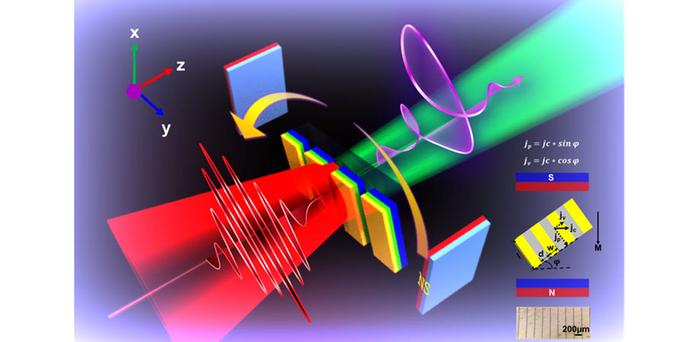In the ever-evolving landscape of photonics and terahertz technology, a groundbreaking advancement has been made by researchers at Beihang University in China. Their work on a uniquely patterned spintronic terahertz emitter promises to redefine the control of chirality in terahertz wave generation. This innovative approach tackles long-standing challenges in terahertz applications, especially in terms of polarization control. By integrating modulation capabilities directly into the emitter’s design, this advancement brings significant potential for faster and more efficient data transmission, imaging, and sensing.
Terahertz (THz) waves sit at the intersection of infrared light and microwaves within the electromagnetic spectrum. Their unique ability to penetrate various nonmetallic materials without causing damage makes them incredibly valuable in diverse fields such as medical imaging, security screening, and wireless communication. However, one of the main obstacles in utilizing THz waves effectively has been the challenge of polarization control. This is crucial for optimizing applications, improving data quality, and enhancing imaging techniques.
Traditional methods of controlling THz polarization depend heavily on cumbersome external optical components like wave plates or metamaterials. While these solutions have served their purpose, they often fall short when it comes to efficiency, frequency range, and applicability within compact devices. To address these inefficiencies, the researchers shifted their focus to controlling polarization at the source of THz wave generation, a move that promises to simplify and enhance the technology significantly.
The team developed a spintronic THz emitter characterized by microscale stripe patterns. This innovation allows for real-time modulation of chirality during the process of THz wave generation. Unlike traditional emitters that require external components, the design of this new emitter incorporates polarization tuning directly into its fabric, leading to streamlined technology and increased adaptability. The emitter consists of a multilayered thin-film structure, including materials like tungsten, cobalt-iron-boron, and platinum.
When subjected to ultrafast laser pulses, the unique composition of the emitter generates spin currents that are subsequently converted into electrical charges via the inverse spin Hall effect. The introduction of microscale stripes patterns dramatically alters the distribution of these charges, resulting in the formation of a built-in electric field that effectively influences both the amplitude and phase of the emitted THz waves. By engineering various stripe configurations, the researchers gained the capability for precise polarization tuning without relying on external optical elements.
One of the standout features of this groundbreaking emitter design is the capacity to switch effortlessly between linear, elliptical, and circular polarization states merely by rotating the device. This flexibility is crucial in applications that demand high-quality circular polarization, which the device manages to uphold with an impressive ellipticity greater than 0.85 across a wide frequency range—from 0.74 THz to 1.66 THz. Such a broad operational window signifies a substantial leap in polarization control capability.
To evaluate the emitter’s performance, the research team explored and tested seven distinct designs, each featuring a unique stripe aspect ratio. Utilizing THz time-domain spectroscopy, they thoroughly measured how these different patterns affected the emitted THz polarization. These experiments substantiated a critical finding: larger stripe aspect ratios yield stronger built-in electric fields, resulting in enhanced polarization control. Certain designs effectively facilitated THz wave generation with tunable polarization, and adjusting the azimuth angles of the stripe patterns allowed for precise transitions between left- and right-handed circular polarization, marking a significant advancement over existing THz sources.
The implications of this technology extend far beyond mere academic interest. The ability to control THz wave polarization with such precision could transform fields such as wireless communication, particularly by doubling data transmission rates through polarization multiplexing. Furthermore, the enhanced sensitivity and accuracy of biomedical imaging resulting from this innovation could lead to earlier and more reliable disease diagnosis, ensuring timely medical intervention.
Moreover, this enhanced control over THz waves opens the door to significant advancements in quantum optics and precision sensing. As researchers delve deeper into these avenues, there’s vast potential for breakthroughs that could reshape our understanding and applications within these fundamental physics domains. Additionally, given the compact nature of this spintronic emitter, it holds immense promise for on-chip integration, which is a critical step towards creating scalable, cost-effective THz devices that can be deployed in real-world environments.
The trajectory of this research hints at a future where the untapped potential of terahertz technology can finally be realized. This work not only sheds light on fundamental physical principles but also embraces an engineering mindset by pushing the boundaries of what is technically feasible. The ambitious goals set forth by this research team will undoubtedly add depth and excitement to ongoing explorations in the sciences.
Looking ahead, future research will target refining the emitter’s frequency-selective control mechanisms. By advancing the technology further, researchers hope to unveil more sophisticated applications for photonic systems and wireless communication platforms, ultimately leading toward advanced THz systems that could fundamentally alter the way these technologies are perceived and utilized.
In conclusion, this advancement in terahertz technology signifies a transformative moment for both researchers and practitioners across multiple fields—from telecommunications to medical diagnostics. The innovative ways this team from Beihang University has harnessed the potential of spintronics to fine-tune THz polarization represents a promising trajectory toward practical applications that could greatly benefit society. In the grand scheme of scientific progress, breakthroughs such as these are vital as they pave the way for future innovations that could help solve pressing global challenges.
Subject of Research: Spintronic Terahertz Emitters
Article Title: Broadband polarization spectrum tuning enabled by the built-in electric field of patterned spintronic terahertz emitters
News Publication Date: 20-Mar-2025
Web References: Advanced Photonics
References: Q. Yang et al., “Broadband polarization spectrum tuning enabled by the built-in electric field of patterned spintronic terahertz emitters,” Adv. Photon., 7(2), 026007 (2025), doi: 10.1117/1.AP.7.2.026007
Image Credits: Q. Yang et al., 10.1117/1.AP.7.2.026007.
Keywords: Terahertz waves, polarization control, spintronics, photonics, wireless communication, biomedical imaging.




